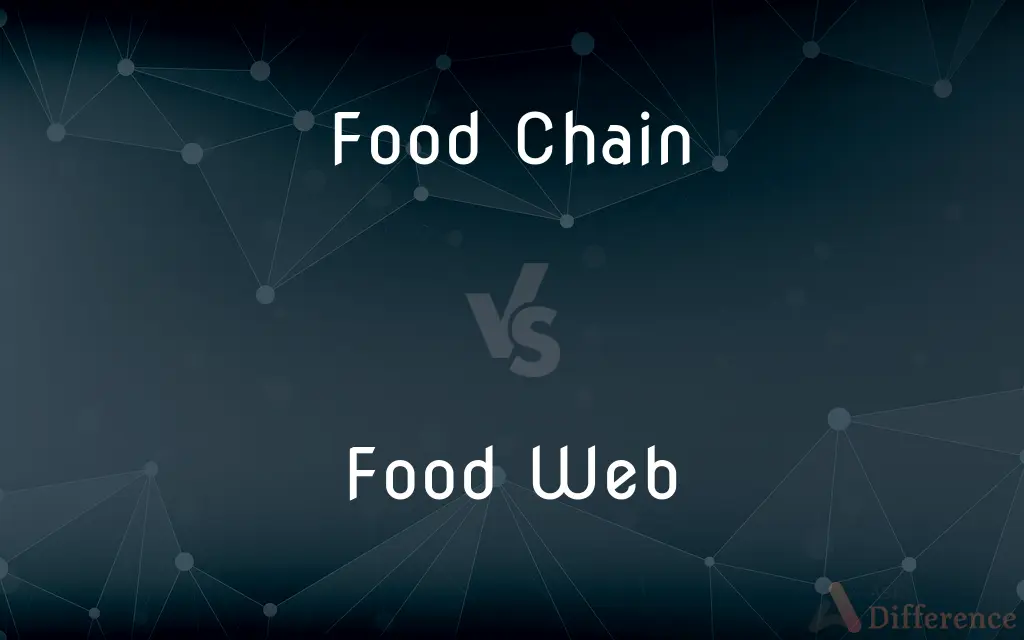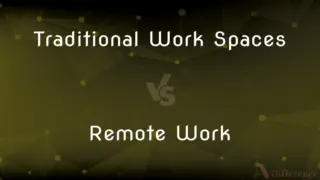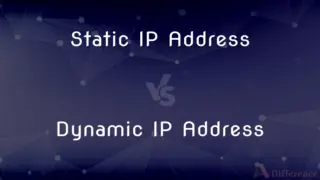Food Chain vs. Food Web — What's the Difference?
By Tayyaba Rehman — Published on January 17, 2024
A food chain is a linear sequence of organisms where each is eaten by the next member in the chain, while a food web is a complex network of interconnected food chains showing feeding relationships in an ecosystem.

Difference Between Food Chain and Food Web
Table of Contents
ADVERTISEMENT
Key Differences
A food chain illustrates a simple, direct pathway of energy flow between organisms in an ecosystem, where one organism is eaten by another. In contrast, a food web depicts multiple food chains that are interconnected, showing how different paths intersect and how various organisms are interdependent.
Food chains often start with a primary producer (like plants) and end with top predators, demonstrating a single line of energy transfer. Food webs, however, represent a more realistic view of energy flow, encompassing various producers, consumers, and decomposers in an ecosystem.
In a food chain, each organism occupies a specific trophic level, defined by its position in the sequence. The food web, however, displays organisms that can occupy multiple trophic levels depending on their feeding habits and interactions with other species.
Food chains tend to be oversimplified models, useful for understanding basic predator-prey relationships. Food webs provide a comprehensive and detailed representation of how nutrients and energy move through an ecosystem.
The stability of an ecosystem can be more accurately gauged through a food web, as it illustrates the complexity and interconnectedness of the ecosystem. A food chain, due to its simplicity, may not reflect the resilience or vulnerability of an ecosystem to changes.
ADVERTISEMENT
Comparison Chart
Structure
Linear sequence of organisms.
Complex network of interconnected food chains.
Energy Flow
Direct and simple pathway.
Multiple pathways and interactions.
Trophic Levels
Each organism occupies a specific level.
Organisms can occupy multiple levels.
Ecological Model
Simplified view of predator-prey relationships.
Detailed representation of ecosystem interactions.
Stability Indication
Less effective in illustrating ecosystem stability.
Better illustrates ecosystem complexity and stability.
Compare with Definitions
Food Chain
A linear sequence showing who eats whom in an ecosystem.
In the grassland food chain, grass is eaten by rabbits, which are eaten by foxes.
Food Web
More realistic representation of ecosystem dynamics.
Studying the rainforest food web helps understand its biodiversity and complexity.
Food Chain
Simple model for understanding basic ecological relationships.
Food chains are fundamental in teaching about ecological interactions.
Food Web
A complex network of interconnected food chains in an ecosystem.
The forest food web includes various interactions among plants, insects, birds, and mammals.
Food Chain
Often begins with a producer and ends with a top predator.
The forest food chain starts with trees and ends with the eagle.
Food Web
Represents multiple trophic levels and feeding paths.
In the food web, a bear occupies multiple trophic levels, eating both fish and berries.
Food Chain
Demonstrates a direct transfer of energy between organisms.
The food chain from algae to fish to seals shows energy flow in the ocean.
Food Web
Illustrates diverse feeding relationships and energy flow.
A marine food web shows how energy is transferred from plankton to various sea creatures.
Food Chain
Each organism occupies a specific trophic level.
In a food chain, plants are primary producers, and lions are apex predators.
Food Web
Indicates the stability and resilience of an ecosystem.
The food web’s complexity can be an indicator of the ecosystem’s health.
Common Curiosities
What is a food web?
A complex network of interconnected food chains in an ecosystem.
Can an organism be part of multiple food chains?
Yes, in a food web, organisms can be part of multiple food chains.
Why is a food web more realistic than a food chain?
It illustrates the complexity and interdependence of organisms in an ecosystem.
What is a food chain?
A linear sequence of organisms where each is consumed by the next.
How does a food web show ecosystem stability?
By illustrating the diversity and interconnectedness of feeding relationships.
Can a food chain exist independently in nature?
Rarely, as most organisms are part of a complex food web.
What happens to a food web when a species goes extinct?
It can disrupt the balance, affecting other organisms in the web.
How do food chains affect biodiversity?
They reflect and influence the biodiversity within an ecosystem.
How does a food chain work?
It shows a direct pathway of energy transfer from one organism to another.
Are humans part of food webs?
Yes, humans are part of many food webs.
Is a food web static?
No, it changes with the introduction or removal of species and environmental changes.
Why are food webs important in ecology?
They help understand the balance and health of ecosystems.
What's an example of a simple food chain?
Grass → Rabbit → Fox is a simple food chain.
What’s at the start of most food chains?
Usually, a primary producer like a plant.
Do food chains and webs only exist on land?
No, they exist in aquatic environments and oceans too.
Share Your Discovery

Previous Comparison
Traditional Work Spaces vs. Remote Work
Next Comparison
Static IP Address vs. Dynamic IP AddressAuthor Spotlight
Written by
Tayyaba RehmanTayyaba Rehman is a distinguished writer, currently serving as a primary contributor to askdifference.com. As a researcher in semantics and etymology, Tayyaba's passion for the complexity of languages and their distinctions has found a perfect home on the platform. Tayyaba delves into the intricacies of language, distinguishing between commonly confused words and phrases, thereby providing clarity for readers worldwide.












































